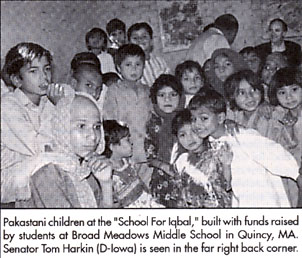 YOUNG ADVOCATES MAKING A DIFFERNECE |
|
|
On the cusp of a new generation's emergence, anxious eyes look towards youth. Numbering 22.5 million strong, 12 to 17 year olds represent our nation's future, wielding significant cultural, economic, and political influence. What are the defining characteristics of these future adults? What kind of workers, thinkers, movers and shakers will they be? How will they fare in an increasingly global economy, marketplace, and mind set. To glimpse a partial answer - no representative sample can speak for an entire generation - the National Consumers League invited a handful of young leaders to speak at our 1998 Centennial Countdown Conference, "Focus on Youth: The New Consumer Power." These are people who are looking toward the future and trying to influence it as well - through intervention, advocacy, and education. Donnel Selder, a 17-year-old senior in Dade City, Fla., is a volunteer on the Teen Dream Team, a project of Farmworkers Self-Help. The Teen Dream Team is a club for farmworkers and other poverty entrenched youth in the five-mile radius of Lock Street in Dade City, an area of high youth crime, gang-related activity, violence, and drug trafficking. The project aims to increase graduation rates among at-risk youth, improve relations among parents, their children and school personnel to help stem the tide of school dropouts. |

|
The program offers intervention, counseling, and weekly youth meetings. What does Selder find is the most satisfying aspect of his volunteer work? He states the one-on-one with teens: "Taking their view - understanding the problems they face. Even though I am of a different race than they are, I can relate to their problems."
Teen Dream Team volunteers, such as Selder, talk to teachers and principals on behalf of teens "I help them have a voice in their community and futures, I am an advocate for teens. They need to feel there is someone who will fight for them." Selder estimates that he puts 18-20 hours a week into the Teen Dream Team. He adds this to a schedule of 17-23 hours a week at a local grocery store. What keeps him going, given his busy life of school, friends, and family? "Knowing I am helping people and my community," he says. "Realizing there are people less fortunate. If I can help them strive to be successful - it's like a gift to me."
The gift of a school was the goal of a group of students at Broad Meadows Middle School in Quincy, Mass. The "School for Iqbal" opened in November 1996 in Kasur, Punjab Province of Pakistan, where Iqbal Masih (a 12-year-old anti-child labor activist) was born, sold into bonded labor, and later murdered. Today, 278 poor, working children between the ages of 4 and 14 attend the school; 252 of these children had never gone to school before.
Elizabeth Bloomer, a 12-year-old seventh grader, became involved in the project after viewing likes of children working. "I believe child labor is wrong,: says Bloomer, "and I wanted to help stop it. A lot of children want to help other children their age."
And they did. The students built a network of concerned school children across the country, raising donations form students in all 50 states and 28 countries, a few dollars at a time.
"The Kids Campaign to Build a School for Iqbal" has received 3,750 different donations totaling over $151,00 guaranteeing the operation of the school for years to come. The Broad Meadows students and their Pakistani partner SUDHAAR have also recently awarded fifty miniloans to poor families so they can buy back children they sold into bonded labor on the condition they enroll their child at Iqbal's school. Does she believe the student efforts have made a difference? "Yes, we've built a school. We pictures for the kids. We made a difference in Pakistan," said Bloomer.
Currently, the Broad Meadows students are spearheading an Online March Against Child Labor. Individuals or groups are asked to send an e-mail message calling for an end to forced, abusive child labor. The messages will be delivered to the delegates at the June 1 International Labor Organization meeting in Geneva where a new convention on child labor will be considered. The goal of the Online March is to collect 3,000 e-mail messages, symbolizing "a virtual mile" marched against child labor across the United States.
One of the most interesting aspects of the Kids Campaign is that it is on its second generation of student leaders and still going strong. Bloomer, in her first year on the project, estimates that she puts in approximately eight hours a week on the Kids Campaign. "We don't want our work to end with this one school," she says. "We don't want our work to end after the on-line march. But, we are focusing on one thing at a time. We have not made plans for what's next."
"We hear so much about apathetic youth, and not enough about kids like Donnell and Elizabeth," says NCL President Linda F. Golodner. "Children are our future. With people like them, our future looks brighter."